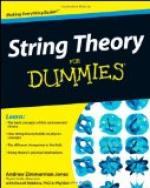|
This section contains 873 words (approx. 3 pages at 300 words per page) |

|
Sometime in the fifth century B.C., the Greek philosopher Democritus introduced the atomic hypothesis--the idea that all matter is composed of extremely tiny, indivisible bits. (Hence the name, atom, which comes from the Greek atomos, "uncuttable.") That reductionist model, in which a few types of fundamental particles suffice to build everything that is, has, remarkably, lasted twenty-five centuries. But the current idea of which particles are actually fundamental has not. Since the turn of the last century it has been discovered that atoms have internal structure, a heavy nucleus surrounded by much lighter electrons. That nucleus is constructed of protons and neutrons, which, in their turn, are built of quarks.
Until 1967, it was thought that there were just four fundamental forces: the strong nuclear force, the weak nuclear force, the electromagnetic force, and gravity. But that year Steven Weinberg and Abdus Salam showed that the...
|
This section contains 873 words (approx. 3 pages at 300 words per page) |

|


